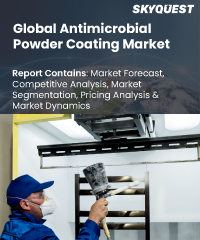
Report ID: SQMIG35D2189

Report ID:
SQMIG35D2189 |
Region:
Global |
Published Date: February, 2024
Pages:
157
|
Tables:
64 |
Figures:
75
Antimicrobial Powder Coating Market size was valued at USD 1.20 Billion in 2021 and is poised to grow from USD 1.34 Billion in 2022 to USD 3.2 Billion by 2030, at a CAGR of 11.5% during the forecast period (2023-2030).
The global antimicrobial powder coating market is witnessing significant growth due to increasing awareness about the importance of hygiene and infection control. The demand for antimicrobial powder coatings is driven by factors such as the growing emphasis on cleanliness and hygiene, rising healthcare-associated infections, and stringent regulations regarding antimicrobial protection in various industries. One of the key drivers of the antimicrobial powder coating market is the increasing awareness and concern about microbial contamination and its impact on public health. As the world becomes more conscious of the potential risks associated with microbial growth, there is a growing demand for antimicrobial coatings that can help prevent the spread of harmful microorganisms and improve overall hygiene. Additionally, the COVID-19 pandemic has further intensified the need for effective antimicrobial solutions, leading to an increased adoption of antimicrobial powder coatings in various sectors. Furthermore, the healthcare industry is a major driver for the antimicrobial powder coating market. In hospitals and healthcare facilities, where the risk of infections is high, antimicrobial coatings play a crucial role in reducing the transmission of pathogens and ensuring a safe environment for patients and healthcare workers. The increasing number of healthcare facilities globally, along with the growing focus on infection control measures, is fueling the demand for antimicrobial powder coatings in the healthcare sector. However, the antimicrobial powder coating market also faces certain challenges. One of the significant challenges is the cost associated with antimicrobial coatings. Antimicrobial additives used in powder coatings can be expensive, which can affect the overall cost of the coating process. The higher cost of antimicrobial powder coatings compared to conventional coatings may limit their adoption in price-sensitive industries. Additionally, regulatory compliance and testing requirements pose challenges for manufacturers in the antimicrobial powder coating market. Antimicrobial coatings need to undergo rigorous testing to ensure their efficacy, safety, and compliance with regulatory standards. Meeting these requirements adds to the cost and time involved in developing and commercialising antimicrobial powder coatings.
US Antimicrobial Powder Coating Market is poised to grow at a sustainable CAGR for the next forecast year.
Our industry expert will work with you to provide you with customized data in a short amount of time.
REQUEST FREE CUSTOMIZATIONWant to customize this report? This report can be personalized according to your needs. Our analysts and industry experts will work directly with you to understand your requirements and provide you with customized data in a short amount of time. We offer $1000 worth of FREE customization at the time of purchase.

Report ID: SQMIG35D2189